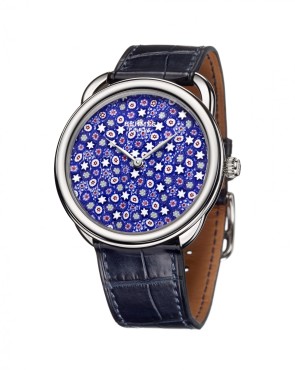As the Hermès group is a fount of traditional artisanal knowledge in numerous fields from leather-working and silk-screening to silversmithing, this time its watchmaking arm decided to turn to Cristalleries Royales de Saint-Louis (Saint-Louis Royal Crystal-Works), a 100 per cent Hermès-owned affiliate company based in Lorraine in northeastern France, to help it create a series of wristwatches and pocket watches embellished with unconventional crystal dials and covers inspired by 19th-century paperweights – a signature Saint-Louis product.
Founded in 1586, the manufacture is the only French crystal-maker still capable of creating spherical paperweights using a wide range of skills. Interested in approaching ancient craft techniques from an innovative angle, La Montre Hermès took an artistic métier mastered by the crystal-works, transposed it onto a very thin layer and miniaturized it to fit onto a watch for the creation of its new Arceau Millefiori collection.
Named “millefiori” (Italian for “a thousand flowers”) as it gives the illusion of a real bed of flowers, the glass technique is believed to have been invented by the Romans and given a new lease of life after the Renaissance by Murano glassmakers. In 1845, while it was developing double and triple overlay crystal, Saint-Louis revived millefiori and created its first paperweight balls, which resemble dreamlike magic gardens trapped in a drop of crystal. The spherical paperweights crafted using the traditional millefiori technique became a Saint-Louis specialty, but quickly lost favor after some 15 years and the glassmaking art disappeared along with it, before making a comeback in1953, when the American collector Paul Jokelson commissioned a sulphide model to commemorate the coronation of Queen Elizabeth II.
Since then, Saint-Louis has presented new limited editions of the precious items annually, with not more than 300 pieces produced in total every year currently, depicting motifs ranging from flowers, fruits and bouquets to animals, birds and butterflies. Over the years, some of the finest collections of millefiori paperweights have been built up by well-known personalities like Jeanne Lanvin, King Farouk of Egypt and Colette, and each Saint-Louis paperweight today is the embodiment of ancestral manufacturing methods that the crystal-works re-mastered after a 100-year hiatus.
At Saint-Louis, the millefiori paperweight process begins by a ball-maker dipping a punty (metal rod or blowpipe) into the mouth of a glass-melting furnace known as a “pot furnace”, each containing a color of crystal or enamel, who then twirls the molten material to form a bubble-free mass called a “gob”. This punty is passed from one crystal-maker to another and from workshop to workshop until a monochrome crystal sprue is fashioned, which will serve to form the canes that will in turn produce the millefiori motif. Resembling barley sugar candy canes, these canes are created by applying successive layers of crystal to enamel to reveal the color, and may be accumulated to form increasingly-complex patterns.
A crystal-worker takes a gob of molten crystal to which a second craftsmen applies his punty, then distances himself as far as the temperature of the material allows, pulling or drawing with him a several meter-long, thin, solid and cylindrical thread measuring just a few millimeters in diameter, colored or made up of a bundle of different colors, which will then be cut when cold into 10-mm long sections and placed vertically inside a cast-iron bowl, where they form what appears to be a flowerbed. These sections of multicolored glass rods, or “English bonbons”, are arranged in a pattern to create a specific motif or at random, and this layer of millefiori is then hit and each “bonbon” gets stuck to one another, before a clear ball of crystal is added on top of it.
Specialized glassmakers select the motif, décor and subject of each paperweight, which is then encapsulated in crystal glass, made under high heat with canes of colored crystal and shaped with blowtorch, pincers and shears, crafted at 550°C and assembled at 1,100°C. If the temperature is too low, the ball shatters, and if it is too high, it becomes cloudy. The artisans in the workshop display great dexterity in placing the multi-colored rods of a millefiori design. The assembly process, or “empaquetage” in French, enables different elements to be inserted into a clear crystal ball, which must never fall below a temperature of 500°C. It is a work of absolute precision – only possible after years of experience – as it is highly challenging to pull the millefiori rods rapidly, to prevent air bubbles from getting trapped and to avoid deforming the pattern when it is covered with clear crystal.
Philippe Delhotal, Creative and Development Director of La Montre Hermès, says, “We collaborated with Saint-Louis for the first time when we launched the Hermès Atmos clock early in 2013. At the time, we visited the paperweight workshop and discovered an exceptional craft. Saint-Louis has magnificent paperweights with beautiful creations. However, this craftsmanship is not very popular anymore and we thought about giving it a new breath. We took the challenge to try to apply this technique to a watch for a dial. The team was very keen on this and took it up as a big challenge. We had to adapt the techniques used for the production of paperweights to the watch dial by producing smaller canes and specific tooling. We were so excited when after several attempts we finally succeeded, as this material is so delicate for a very thin cut.”
Written By Y-Jean Mun-Delsalle for Forbes Photos: Hermes